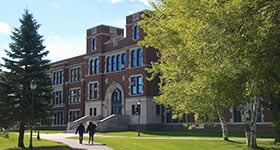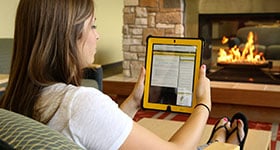An important development in modern special education is the advent of assistive and adaptive technologies that teachers can use to help their students learn and achieve at the highest levels possible. The vast majority of students with special needs do not have cognitive impairments. Many of these students can learn and perform as well as those without disabilities when given adjustments to certain aspects of their environment to accommodate for various physical disabilities. And educators can make many simple accommodations for students with cognitive disabilities to similarly help maximize their learning in the inclusive classroom. Simple adjustments in the depth of information and how that information is presented can greatly aid a student who has difficulty with traditional teaching and assessment techniques.
Because assistive technologies have become such an important part of special education, the University of Wisconsin-Superior’s online Master of Science in Education — Special Education program includes courses that cover these technologies. These courses are designed to help degree candidates learn the effective use of assistive technologies in a classroom with differentiated instruction practices. In addition, other courses such as “The Exceptional Learner” and “Behavioral Analysis and Intervention” give educators a thorough understanding of students’ unique needs and how to best accommodate them using assistive technologies.
Differentiation of Instruction Through Accommodating Input and Output Mediums and Methods
The simplest form of accommodation for students with special needs is differentiating the way they receive and give information. Adjusting the depth of content to suit their learning needs and the methods used to assess their performance are also straightforward ways of differentiation.
For instance, students who have trouble reading due to a learning disability may excel and process information more effectively if they receive the content in audio form. Additionally, they may have a much easier time showing what they have learned by discussing it in monitored group settings or by giving an oral presentation. But just as visual learners have written materials they can reread until they achieve a deep level of knowledge on the subject, auditory learners should be given audio materials that they can listen to as many times as needed to properly process the information.
In this example, a simple accommodation could be made with assistive technology by providing students with audio players and recordings of content materials. And on the output side, the students could be given audio recorders to record their assessments and show what they have learned.
Using Computers, Tablets and Visual Displays to Accommodate Visual and Tactile Learners
Similar to auditory learners, some students with special needs respond best to visual engagement with information. Using visual displays, drawings and such has long been a well-utilized method of engaging visual learners. Given the wealth of technologies available currently, this mode of engagement is not only more appropriate but also more successful than ever. Students can design and model science projects with a tablet app. They can proceed through an interactive history lesson on a computer. A creative teacher can figure out how to incorporate such visual assistive technologies into most any subject.
Computers, tablets, and other interactive technologies can help teachers accommodate many other learners’ needs as well. The interactive nature of tablet lessons and educational games can be exactly what a tactile learner needs to succeed, literally working their way through learning and information by touch, sound and sight.
There are good reasons why many tactile learners devote so much time to playing video games, often reading and communicating through that medium at much higher grade levels than reflected in their school performance. These games engage their hands, sight and social communication all at the same time, in effect growing their weaker learning skills by synthesizing them with their stronger skills. So, naturally, educational games that strive for this level of holistic engagement can have a similar effect.
Creating a Collaborative, Global Classroom to Promote Self-Esteem, Social Skills Development and Positive Behavior
Students with learning disabilities often experience a negative cycle of behavioral conditioning in school. They can develop low levels of self-esteem due to difficulties learning, compounded with the perceived negative stigma that learning disabilities can have. In certain situations, this negative cycle of behavioral conditioning and low self-esteem can cause students to develop poor social skills, have trouble with peer interactions, and act out repeatedly in class.
But with new, assistive digital technologies and instantaneous communication, students can learn socially through a virtual medium, which builds their self-esteem in both their own academic abilities as well as their social abilities. With these technologies, teachers can create collaborative, global classroom environments, connecting students with other students around the world, encouraging them to work together across cultural borders.
Becoming a culturally responsive citizen is essential to success in the modern, globalized world. And, as the point of special education is to ready students for college and life after school, engaging them with the global community through assistive technology and positive group interaction can help many aspects of students’ cognitive and social development.
Assistive Technologies for Students With Visual Impairment
A student who is visually impaired but does not have any cognitive disabilities should be able participate fully in the general education classroom, given assistive devices appropriate to that student’s level of vision. These can be thought of merely as tools, as with any other writing or reading device. Screen reader software will dictate text on a computer to the student. A host of braille writing and refreshable reading display equipment exists so students can read (and write) silently. Screen and video magnifiers enlarge text to assist students with mild visual impairment. Various adaptive keyboards help students develop hands-free typing skills. Computer programs and apps for tablets come equipped with gesture-based commands and text-to-speech modes to facilitate non-visual use. The list goes on and on.
Other Examples of Assistive Technology in Special Education
There is truly no limit to the ways teachers and students can adapt the environment to suit a student’s needs. Closed captioning and hearing aids can assist students with hearing impairments. Wheelchairs, prosthetics and other such equipment can help students with mobility impairments. Adaptive interfaces and structural accommodations of many kinds can be used to help students complete everyday activities, from special pencil grips for writing to the ramps, handrails, elevators and automatic door openers found in public buildings. Even adventure education ropes courses can be adapted for use by those with extreme physical disabilities through employing specialized harness-and-pulley systems.
The quantity and quality of content and mediums available to teachers with modern, assistive technologies can allow them to differentiate learning intensively. Combined with myriad adaptive instruction techniques, these technologies can give teachers the opportunity to actively and successfully engage all students. And, most importantly, these technologies can afford students with disabilities of all sorts a full and equal education within the inclusive classroom.
Learn more about the UW-Superior online MSE Special Education program.


